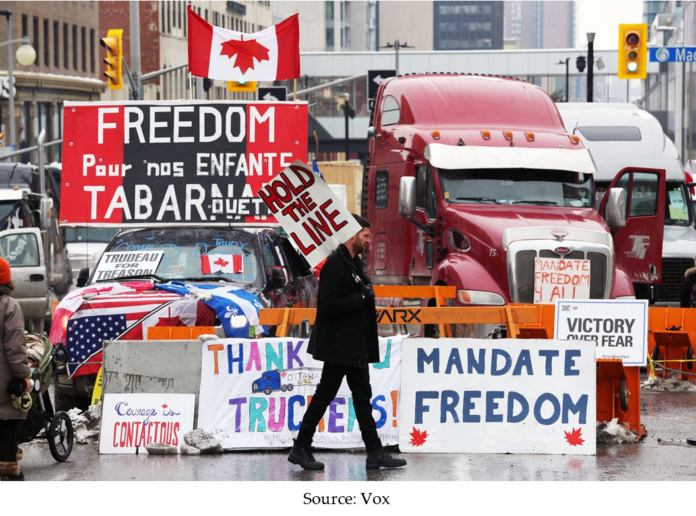By Simon Li and Jonah Ruddock
We will move forward as a nation that is united, happy, and full of love. We will build something beautiful.
Or so say the organizers of the Freedom Convoy, a series of protests and demonstrations that have shut down various cities, including Canada’s capital of Ottawa. With the streets of Ottawa mostly cleared, and the protest dispersed, it is unclear how much “building up” the protestors did. Perhaps, they did succeed at one thing: Canadians are moving forward in a world without the Freedom Convoy.
The Freedom Convoy
On January 28th, truck drivers congregated in Ottawa for a so-called “freedom convoy” to protest the new requirement for all cross-border truck drivers to be vaccinated. This evolved into a broader movement demanding an end to COVID restrictions. For the next three weeks, truckers and protestors alike besieged the capital, managing to terrorize and effectively shut down the city. New Democratic Party leader Jagmeet Singh stated that the organizers “are very clearly connected to the extreme right wing” and “have a goal in mind to undermine democracy.”
With the support of high profile benefactors like Elon Musk and Tom Siebel as well as ordinary Americans and Canadians, the Freedom Convoy garnered eight million dollars in donations on GoFundMe. However, this was all returned to donors after February 5th, when GoFundMe removed the fundraiser from their website after saying it had violated Term 8 of their Terms of Service, which prohibits the promotion of violence and harassment. Protest organizers then began to raise money on crypto fundraising site Tallycoin. Their account, HonkHonkHodl, managed to raise 500,000 dollars in Bitcoin. In a series of unprecedented legal maneuvers–including a class-action lawsuit from Ottawa residents and the invocation of the Mareva injunction–many crypto accounts were frozen.
On February 14th, allegedly the day of love, Justin Trudeau enacted the Emergencies Act for the first time, allowing the Canadian federal government and the police to take extraordinary measures to combat public emergencies. Ottawa police thus began a large-scale, three day operation to clear the nation’s capital. Using crowd control tools such as pepper spray and stun grenades, the police arrested hundreds of protestors, including key organizers. On February 23th, with the protests over, Trudeau revoked the act.
However, the loudest voices often do not represent the majority of voices. Accordingly, the protests were wildly unpopular in Canada, with all polls showing that a majority of Canadians opposed it. For example, 62% of Canadians opposed the Freedom Convoys, from a poll released by Leger and the Association for Canadian Studies. In addition, trucking organizations such as the Canadian Trucking Alliance and the Ontario Trucking Association disavowed the protests from the very start.
Rationale Behind the Convoy
The protestors originally consisted of a vocal minority of the trucker community, as 90% of truckers in Canada are already vaccinated. The truckers’ numbers grew to include anyone who opposed COVID restrictions like mask mandates and vaccine passport check-ins. The protesters occupied residential neighborhoods with raucous parties, costing the city 800,000 dollars a day in policing expenses and disrupting the U.S.-Canadian cross-border trade.
Many of the protestors were nonviolent, simply angered by COVID mandates that had negatively affected their livelihoods or infringed upon their beliefs. Some described themselves as human rights activists. However, far-right extremists have used the movement as a vessel to spread their own ideology. It proved a ripe breeding ground, as mistrust of the government and anti-Trudeau sentiments were already present. Evidence has been found that Diagolon, a right-wing militia network with a stated intent to topple the Canadian government, was involved in some of the Alberta protests, and a few protestors have also touted Nazi and Confederate flags. The police uncovered a stash of guns, ammunition, and machetes from a fringe group of protestors at the Alberta-Montana blockade, leading to four people being charged with a conspiracy of murder and dozens of others facing lesser charges.
Signs of the right-wing’s rise can be seen elsewhere as well. On the national level, the conservative party of Canada has kicked out its moderate leader, Erin O’Toole, in the belief that he had taken the party too far away from its conservative social values, with the last straw coming from O’Toole’s denouncements of conversion therapy and his ambiguous stance on the trucker convoys.
Freedom Convoys Outside of Canada
The Freedom Convoy did not just have ramifications for Canada—sparking spin-off trucker convoys in countries such as the United States (that’s where we live), Australia, New Zealand, and France. Organizers on popular right wing social media platforms, such as Facebook, have encouraged Americans to mobilize and head to D.C. to protest vaccine mandates. Plans of a potential American “freedom convoy” vary wildly, however, disagreeing on when and where it will take place. One such convoy, the “People’s Convoy”, lists their departure date as February 23rd, starting in California, passing through Arizona, New Mexico, Texas, Oklahoma, Missouri, Illinois, Indiana, Ohio, Pennsylvania, and Maryland before making their way to D.C in early March.
Still, the federal government isn’t taking chances. With the January 6th insurrection still fresh on the minds of many, D.C. residents are still on guard and alert. At the request of the D.C. government and the US Capitol police, the Pentagon authorized the deployment of 700-800 National Guard troops and 50 large tactical vehicles to monitor the situation and help control traffic in the event that the Freedom Convoy materializes. Whether or not any disruptions and protests do happen, however, remains to be seen.

